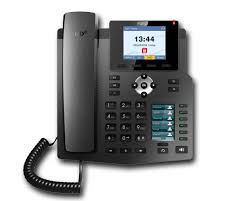IP PBX system kerala

Fanvil X3G PoE Gigabit IP Phone
January 4, 2023
Why choose IP-PBX over the traditional EPABX system?
January 11, 2023What is IP PBX
An IP PBX (Internet Protocol Private Branch Exchange) is a telephone system that uses internet protocol (IP) networks to provide communications services such as voice, fax, and voicemail. It is similar to a traditional PBX (Private Branch Exchange) system, but instead of using traditional telephone lines, it uses IP networks to connect telephone extensions to the outside world, including other IP PBX systems or the public switched telephone network (PSTN). IP PBX systems can also integrate with other communication and collaboration tools such as instant messaging, video conferencing, and presence information.
Some common features of IP PBX systems
-
VoIP (Voice over Internet Protocol) support: IP PBX systems use VoIP to transmit voice calls over IP networks, which allows for flexible call routing, lower costs, and integration with other communication tools.
-
Automated Attendant: IP PBX systems often include an automated attendant that can answer calls and direct them to the appropriate extension or department.
-
Call routing and forwarding: IP PBX systems can route incoming calls to the appropriate extension based on rules set by the administrator, and also forward calls to a different number or voicemail when the intended recipient is unavailable.
-
Caller ID: IP PBX systems can display the caller’s name and number on the recipient’s phone, allowing them to quickly identify who is calling.
-
Conference calling: IP PBX systems often include support for conference calls, allowing multiple parties to participate in a single call.
-
Voicemail: IP PBX systems typically include voicemail capabilities, allowing users to receive, listen to, and manage their voicemails.
-
Integration with other communication tools: IP PBX systems can integrate with other tools such as instant messaging, video conferencing, and presence information, allowing users to communicate and collaborate more effectively.
-
Scalability and Remote working: IP PBX systems are based on software so its easy to add new users and numbers to the system and also IP-based systems allow users to work remotely by accessing the system through the internet.
-
Reporting and Call Analytics: IP PBX systems can provide reports and analytics on call data such as missed calls, call duration, and call volume.
-
Mobility: IP PBX systems can work with softphone app and allow users to make and receive calls using their mobile devices.
What is EPABX
A EPABX (Private Automatic Branch Exchange) is a telephone system that is used within a private organization, such as a business or government agency. It is also known as PBX (Private Branch Exchange) which is used to connect internal telephone extensions to outside public telephone lines, allowing employees to make and receive external calls without having to use public lines for each call.
EPABX is a traditional telephone exchange system which is based on hardware and wires and provides various services such as call routing, call forwarding, voicemail, call transfer, call waiting, and caller ID, among others. It acts as a central hub for all the telephone communications within an organization, allowing employees to communicate with one another and with external parties.
EPABX systems are also customizable, which means that the organization can configure the system to meet their specific needs and requirements. The system can be programmed to direct calls to specific extensions based on the caller’s input or the time of day, for example. This can help to improve the efficiency of the organization’s communication processes.
The major difference between PABX and IP PBX is the infrastructure and medium they use to transmit the calls. PABX uses traditional PSTN lines while IP PBX uses IP networks to transmit the calls.
Differences between IP PBX and EPABX systems
There are several key differences between IP PBX and PABX systems:
-
Technology: The main difference between IP PBX and PABX is the technology they use. PABX systems use traditional PSTN (Public Switched Telephone Network) lines to transmit calls, while IP PBX systems use internet protocol (IP) networks.
-
Scalability: IP PBX systems are based on software, and as such they are easier to scale as new users and numbers can be added to the system, while PABX systems are based on hardware, which means that adding new users or lines requires the purchase of additional hardware.
-
Remote working: IP PBX systems allow users to work remotely by accessing the system through the internet, while PABX systems require users to be physically connected to the PABX.
-
Integration: IP PBX systems can integrate with other communication and collaboration tools such as instant messaging, video conferencing, and presence information, while PABX systems are typically more limited in their integration capabilities.
-
Cost: IP PBX systems may be less expensive to set up and maintain over time, as they typically do not require the same level of hardware investment as PABX systems and also the calls are made through internet protocol (VoIP) which can be cheaper.
-
Call routing: IP PBX systems use VoIP which provides more flexibility on call routing, call forwarding and other features. PABX based on traditional PSTN lines are more limited in the routing options.
-
Maintenance: IP PBX systems are software based so the maintenance is mostly software updates and patches, while PABX systems are hardware-based so the maintenance would be more physical and costly.
To Know more About Bitvoice IP PBX Systems. Please visit Our Product Page Voxdial PBX



